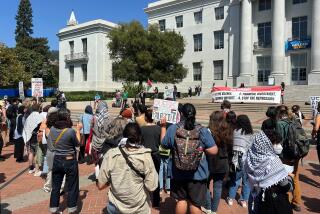Incident at UCSF Described : Radioactive Material Was Spilled in Elevator
- Share via
When a cancer patient undergoing radiation treatment complained of pain at the University of California, San Francisco, Medical Center last April, a doctor promptly concluded that part of the problem was the position in her cervix of a radioactive capsule used to kill a tumor.
The physician, a radiation oncology resident, immediately set about to remove the device. First, he extracted from the patient a hard plastic rod--which he believed to contain the radioactive material--and carefully placed it in a shielded lead container.
Next, he removed a small stainless steel tube and set it aside while he cared for his patient. After she was stabilized, the doctor left her room, carrying the lead container with its plastic rod in one hand and the steel tube in the other.
Unknown to him, however, the plastic rod he had placed in the shielded container was only a harmless device used to position the radioactive cesium 137 capsules in the patient’s cervix. It was the steel tube, known as an applicator, that contained the inch-long cesium 137 capsules--and he was carrying it in his hand.
“He walked through the corridor with the radioactive material basically unshielded,” state health physicist Stuart Rosenberg said Wednesday.
Making matters worse, one of several sealed radioactive capsules fell unnoticed out of the steel tube while the doctor was in an elevator. It wasn’t discovered missing until 2 1/2 hours later during a routine inventory. The doctor’s steps were retraced and the material was retrieved with the help of a Geiger counter.
The incident, which apparently caused no harm, was described Wednesday by the state Department of Health Services as the basis of one of 32 violations filed this week against the UC San Francisco Medical Center in the second crackdown on the misuse of radioactive materials on a university campus in two weeks.
Last week, Los Angeles City Atty. James K. Hahn filed a 179-count criminal complaint against USC and 10 of its researchers. Hahn charged that USC had been “cavalier” in following required radiation safety regulations. USC responded that Hahn’s charges had been “blown out of proportion.”
The state on Monday ordered UCSF to take immediate steps to rectify the deficiencies. State health officials also served notice that their findings will be forwarded to state Atty. Gen. John Van de Kamp for possible civil or criminal prosecution.
Rosenberg said the UCSF incident involving the unshielded cesium 137 pointed up an obvious breakdown in radiation safety training for residents and others working with or near radioactive materials at UCSF. He said the doctor suffered no apparent adverse health effects. He said people who rode in the elevator were probably not in it long enough to worry about exposure to any vital organs.
Still, there have been similar incidents in the past and the notice of violation described them as “very serious.”
UCSF has been directed to act within 15 days to upgrade radioactive safeguards, including mandatory testing within 72 hours of all people possibly exposed to radioactive iodine while handling 100 microcuries or more of the material.
The university was also given 60 days to submit an entirely new application to be licensed to possess and handle radioactive materials.
More to Read
Sign up for Essential California
The most important California stories and recommendations in your inbox every morning.
You may occasionally receive promotional content from the Los Angeles Times.












